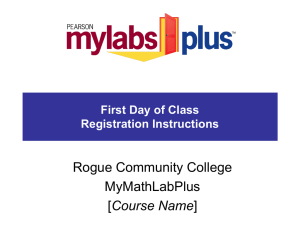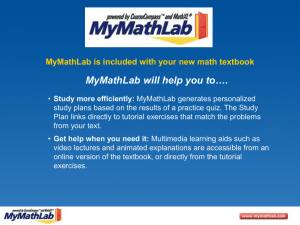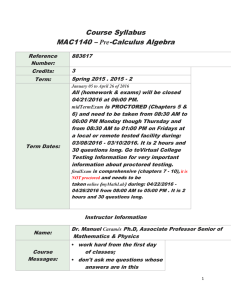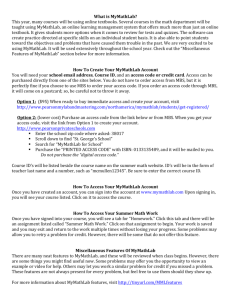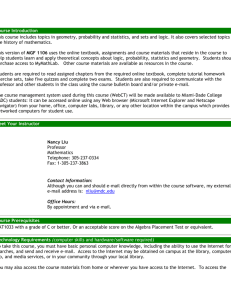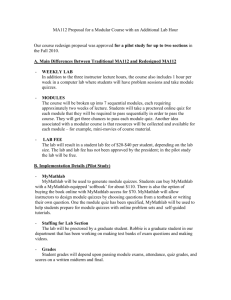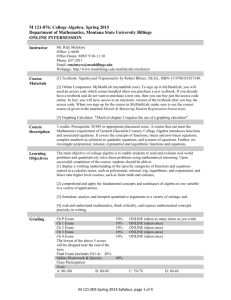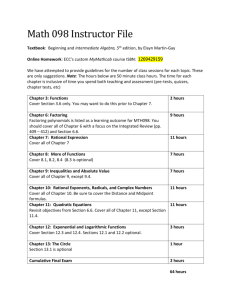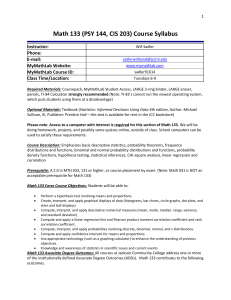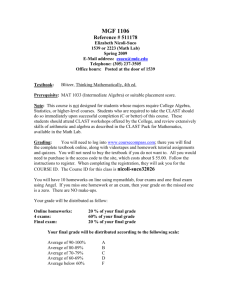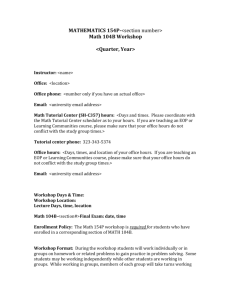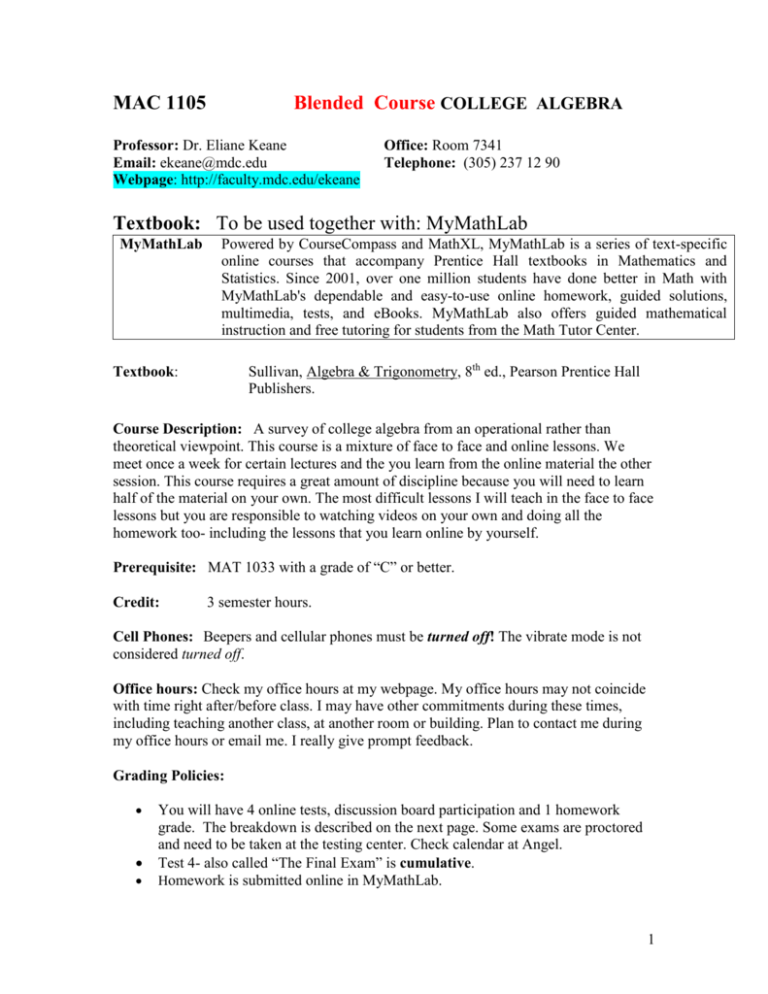
MAC 1105
Blended Course COLLEGE ALGEBRA
Professor: Dr. Eliane Keane
Email: ekeane@mdc.edu
Webpage: http://faculty.mdc.edu/ekeane
Office: Room 7341
Telephone: (305) 237 12 90
Textbook: To be used together with: MyMathLab
MyMathLab
Powered by CourseCompass and MathXL, MyMathLab is a series of text-specific
online courses that accompany Prentice Hall textbooks in Mathematics and
Statistics. Since 2001, over one million students have done better in Math with
MyMathLab's dependable and easy-to-use online homework, guided solutions,
multimedia, tests, and eBooks. MyMathLab also offers guided mathematical
instruction and free tutoring for students from the Math Tutor Center.
Sullivan, Algebra & Trigonometry, 8th ed., Pearson Prentice Hall
Publishers.
Textbook:
Course Description: A survey of college algebra from an operational rather than
theoretical viewpoint. This course is a mixture of face to face and online lessons. We
meet once a week for certain lectures and the you learn from the online material the other
session. This course requires a great amount of discipline because you will need to learn
half of the material on your own. The most difficult lessons I will teach in the face to face
lessons but you are responsible to watching videos on your own and doing all the
homework too- including the lessons that you learn online by yourself.
Prerequisite: MAT 1033 with a grade of “C” or better.
Credit:
3 semester hours.
Cell Phones: Beepers and cellular phones must be turned off! The vibrate mode is not
considered turned off.
Office hours: Check my office hours at my webpage. My office hours may not coincide
with time right after/before class. I may have other commitments during these times,
including teaching another class, at another room or building. Plan to contact me during
my office hours or email me. I really give prompt feedback.
Grading Policies:
You will have 4 online tests, discussion board participation and 1 homework
grade. The breakdown is described on the next page. Some exams are proctored
and need to be taken at the testing center. Check calendar at Angel.
Test 4- also called “The Final Exam” is cumulative.
Homework is submitted online in MyMathLab.
1
Online Homework : (10%) of final grade.
Discussion Board:
(5%) of final grade
Test 1- (10%) Online. See course calendar for dates, times.
Test 2 - (30%) Test Center Proctored - Must pass with at least a 50% See Angel course calendar
for dates and times.
Test 3 - (15%) Online. See course calendar for dates, times.
Test 4 - (30%) In Class Proctored - Must pass with at least a 50% See Outline for date & time.
Grading Criteria
Grading Criteria
Activities
Miami Dade College's Letter
Grades
Percentages
Points
Earned
Letter
Grades
90-100
A
30%
80 - 89
B
Test Unit 3
15%
70 - 79
C
Test Unit 4
30%
60 - 69
D
Total
Percentage
100%
59 and
below
F
Homework
10%
Disc. Board
5%
Test Unit 1
10%
Test Unit 2
YOU MUST EARN AT LEAST A 50% ON BOTH PROCTORED EXAMS TO
PASS THE COURSE.
Homework: All required homework is done through MyMathLab. It is graded
and there are deadlines to it. Homework for each unit is assigned. You may also use
the computer center for assistance with your homework. Remember, students need
practice to retain a concept learned in class. By doing your homework you will probably
set yourself for success in this course.
Assistance: Please feel free to contact me if you have questions. I am always available
to help you during my office hours. Use e-mail or call me if you cannot come to my
office in person. I will respond to your email during my office hours and in a timely
basis: 24 hours during the week and 48 hours during the weekend. The tutorial services
of the Computer Center , room 2222, Building 2, are also available to students registered
2
in any math course taught on campus. Tutors at the computer center may guide you in
your homework. Make full use of many resources available to you: The textbook,
MyMathLab, the computer center, your peers and your professor.
Classroom Etiquette: Please refrain from bringing food or drinks into classroom. You
are expected to arrive on time to class, depart when the class has concluded and treat
others respectfully. You are encouraged to ask questions.
Make-ups: There are NO make-ups on any of the first 3 tests. If you miss one of
these tests, then your grade is a zero. I will use the Final Exam (Test 4) grade to replace
one, and only one, missed test. So, please do not ask for make ups, or show me
documents proving that you had had a reason to be absent because I will not look at them.
Simply plan to attend the final exam and score high because I will double this grade and
will replace it for the zero that you received when you missed the test
Drop Date: If you feel that you will be unable to complete the requirements for passing
a class, it is important that you drop the class by the college's "drop date" as established
by the registrar's office. You should speak to your instructor prior to making the
decision to drop. MANY times there is a solution that you are not foreseeing at that
moment and you may not need to withdraw at all and still pass the course. Work
with me, count on me, before making major decisions such as dropping the class.
Yet, remember that it is your responsibility to drop a class, not the instructor's.
Approximately half-way into the term, your professor will purge her class roll of nonattending students. This is a college requirement. No-shows or students with three (3)
consecutive unexcused absences will be dropped from the course. This may jeopardize
your full time, scholarship, or financial aid status. You are advised not to count on this
process if you wish to drop a course. It is the student’s responsibility to drop a course
before the drop deadline if s/he wishes to receive a grade of W .
Attendance: Attendance is a contributing factor for the successful learning of academic
material. Attendance will be recorded daily and if you arrive late you will be marked
absent. I won’t change it so please do not ask. So, please do not make a big thing out of
it- unless you are coming late all the time. In case of absence, a student is responsible for
the material covered, and will not be allowed to make-up tests given that day (in case you
miss a deadline). In my webpage, I provide a detailed outline of the sections that will be
covered every day of this course. If you need to be absent, please look at this outline so
you can prepare yourself for the next class when you attend.
Notes:
1) A scientific or a graphic calculator is required. No cell phones are to be used as
calculators.
2) The use of calculators is recommended on all tests and on the final exam, but no
sharing of calculators between students is allowed during these times.
3) The professor reserves the right to add, rearrange, or change material to fit the
available time. All changes will be announced during class or in my webpage.
3
Taking Exams:
You MAY NOT leave the room once you have begun taking an
exam. If a student leaves the room during an exam, your test will be submitted and
graded as a completed exam.
Support System: It is very important that within the first week you develop a peer
support system to help you. Find 2 students and exchange (give yours and take
theirs) emails and phone numbers instantly. This way, if you were to miss class you
can find out if there were changes announced in class.
Reading and Writing Components: It is the policy of MDC to emphasize reading and
writing as part of any course whenever possible. We will focus on reading and writing
mathematically as these two elements apply to the learning outcomes of this course.
4
ACKNOWLEDGEMENT
I , __________________________, student ID _______________________,
have read, understood, and agreed to accept the policies and procedures in Dr. Keane’s
course. I understand and take complete responsibility for the consequences of violating
any of the rules described in these policies and procedures.
______________________________
Student’s Name
ELIANE KEANE
Instructor’s Name
______________________________
Student’s Signature
Date: _____________
5
Learning Outcomes
1) Solve linear equations and inequalities involving absolute value.
2) Solve equations involving rational expressions.
3) Solve word problems involving rational expressions.
4) Solve radical expressions.
5) Solve quadratic and cubic inequalities in one variable.
6) Solve inequalities involving rational expressions.
7) Find the distance between two points on a number line.
8) Use the distance formula to find the distance between two points in the plane.
9) Determine the standard form of a circle, and graph the circle.
10) Determine the standard form of a line given certain conditions pertaining to the line.
11) Determine the standard form for the equation of a vertical parabola.
12) Graph a vertical parabola.
13) Determine the terms ‘relation’ and ‘function.’
14) Define the terms ‘domain’ and ‘range.’
15) Find the domain and range of certain functions.
16) Use function notation and simplify the difference quotient for certain functions.
17) Graph linear, quadratic, radical, absolute value, and root functions.
18) Graph piecewise-defined functions.
19) Solve certain maximum and minimum problems by finding the vertex of a parabola.
20) Find the sum, difference, product, quotient, and composition of two functions.
21) Show that a function is one-to-one by using the definition of the horizontal line test.
22) Find the inverse of a one-to-one function.
23) For a simple function f, graph both f and f −1 on the same coordinate system.
6
24) Graph a polynomial function.
25) Graph a rational function.
26) Solve certain exponential equations using the property: If ax = ay, then x = y, a 0
and a 1.
27) Graph both increasing and decreasing exponential functions.
28) Define the statement ‘Y = loga x.’
29) Know the properties of logarithms and solve certain problems which require their
use.
30) Graph a logarithmic and its inverse exponential function on the same coordinate
system.
31) Solve exponential equations using logarithms.
32) Use the change-of-base formula to evaluate logarithms with base other than 10 or e.
33) Graph linear systems and solve these systems by substitution and elimination.
34) Evaluate 2 x 2 determinants.
35) Evaluate 3 x 3 determinants using expansion by minors.
36) Use Cramer’s Rule to solve 2 x 2 and 3 x 3 linear systems.
7


